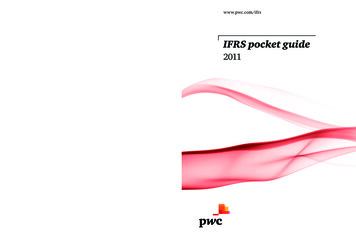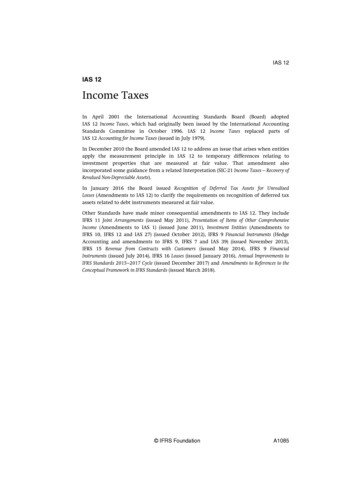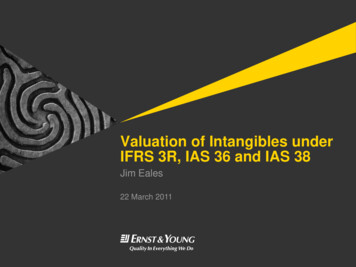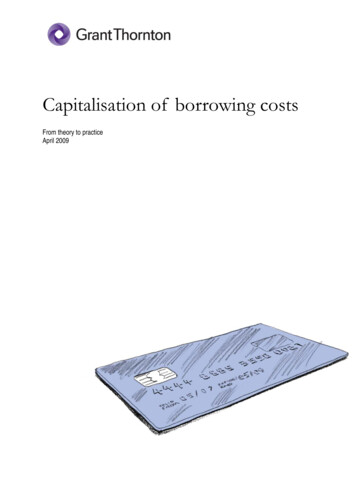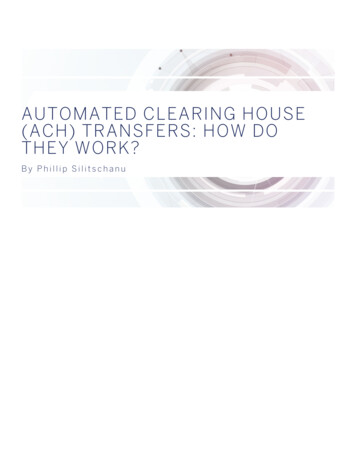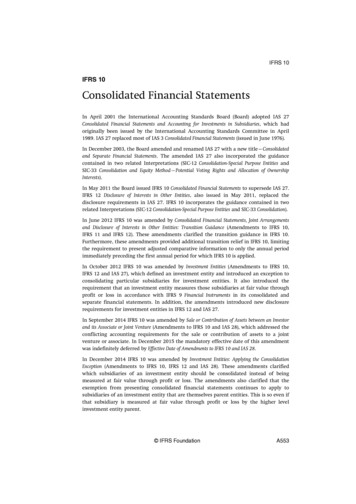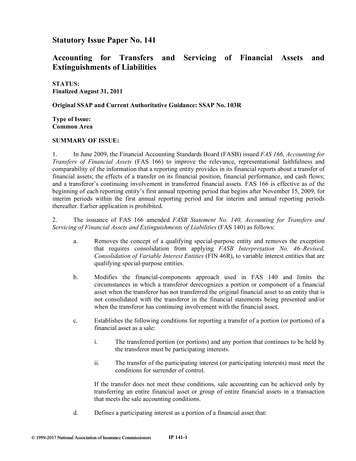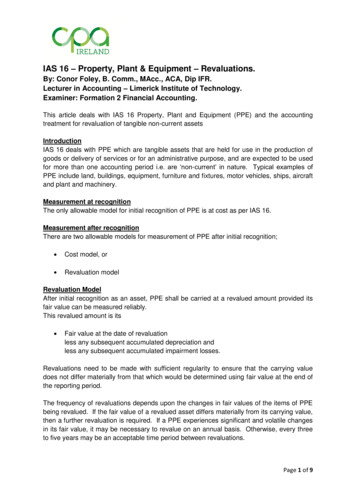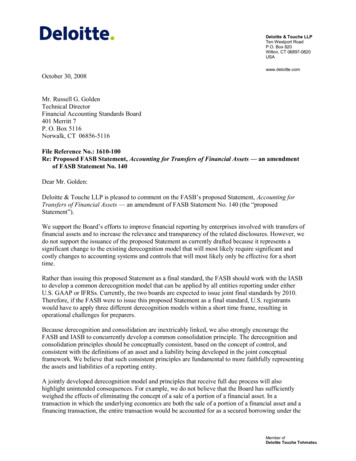
Transcription
Deloitte & Touche LLPTen Westport RoadP.O. Box 820Wilton, CT 06897-0820USAwww.deloitte.comOctober 30, 2008Mr. Russell G. GoldenTechnical DirectorFinancial Accounting Standards Board401 Merritt 7P. O. Box 5116Norwalk, CT 06856-5116File Reference No.: 1610-100Re: Proposed FASB Statement, Accounting for Transfers of Financial Assets — an amendmentof FASB Statement No. 140Dear Mr. Golden:Deloitte & Touche LLP is pleased to comment on the FASB’s proposed Statement, Accounting forTransfers of Financial Assets — an amendment of FASB Statement No. 140 (the “proposedStatement”).We support the Board’s efforts to improve financial reporting by enterprises involved with transfers offinancial assets and to increase the relevance and transparency of the related disclosures. However, wedo not support the issuance of the proposed Statement as currently drafted because it represents asignificant change to the existing derecognition model that will most likely require significant andcostly changes to accounting systems and controls that will most likely only be effective for a shorttime.Rather than issuing this proposed Statement as a final standard, the FASB should work with the IASBto develop a common derecognition model that can be applied by all entities reporting under eitherU.S. GAAP or IFRSs. Currently, the two boards are expected to issue joint final standards by 2010.Therefore, if the FASB were to issue this proposed Statement as a final standard, U.S. registrantswould have to apply three different derecognition models within a short time frame, resulting inoperational challenges for preparers.Because derecognition and consolidation are inextricably linked, we also strongly encourage theFASB and IASB to concurrently develop a common consolidation principle. The derecognition andconsolidation principles should be conceptually consistent, based on the concept of control, andconsistent with the definitions of an asset and a liability being developed in the joint conceptualframework. We believe that such consistent principles are fundamental to more faithfully representingthe assets and liabilities of a reporting entity.A jointly developed derecognition model and principles that receive full due process will alsohighlight unintended consequences. For example, we do not believe that the Board has sufficientlyweighed the effects of eliminating the concept of a sale of a portion of a financial asset. In atransaction in which the underlying economics are both the sale of a portion of a financial asset and afinancing transaction, the entire transaction would be accounted for as a secured borrowing under theMember ofDeloitte Touche Tohmatsu
Page 2October 30, 2008File Reference No. 1610-100proposed Statement and the related amendments to the FASB Staff Implementation Guide (Statement140).1 This could be achieved by the transfer of the financial asset and the retention of a call optionwhen the transferred principal balances have been reduced to a predetermined amount for the portionthat represents a financing transaction. We are concerned that the proposed accounting treatment maynot mirror the underlying economics of the transaction. The FASB and IASB, with the assistance ofpreparers and users of financial statements, should carefully analyze the impact of the newderecognition model as the joint standard is developed.We acknowledge that if the FASB were to remove the project from its agenda and develop a jointstandard with the IASB, the recent practice issues would not be addressed until such standard becomeseffective. We therefore support requiring increased disclosures in the interim. (See our October 15,2008, comment letter to the Board regarding proposed FSP FAS 140-e and FIN 46(R)-e2 (the“proposed FSP”).)If the Board determines that it must issue the proposed Statement, it should consider revising it inaccordance with our comments and suggestions below.Effective Control — Transferee Constraint (Paragraph 9(c)(3))The concept that a “constraint is designed primarily to provide the transferee with a benefit”(emphasis added) in paragraph 9(c)(3) of the proposed Statement is not operational. Specifically, webelieve that it will be difficult for a transferor to conclude that the transferee has primarily benefitedfrom a constraint on its ability to pledge or exchange transferred financial assets that it has received.For example, this concept is difficult to reconcile when the restriction on a transferee that is a specialpurpose entity (SPE) is established by the transferor as contemplated in paragraph 54A of the proposedStatement. Although the Board concluded that the constraint of the transferee was designed primarilyto benefit the transferee in marketing securities to potential beneficial interest holders, we believe thatit is often the transferor that benefits from the ability of the SPE to market securities backed by thetransferred financial assets to beneficial interest holders. This benefit is evidenced by the transferorobtaining proceeds associated with a securitization transaction at a lower cost than those in anunsecured debt issuance. The transferor is usually involved in the design of the securitization vehicleand will typically structure the transaction to meet its needs and those of the guarantor, if any. It isunlikely that the transferor will design restrictions on the transferability of the transferred financialassets primarily for the benefit of the transferee. In addition, when the transferor obtains a beneficialinterest (e.g., through a guarantee, a residual interest in the transferred assets, or a servicingarrangement), it may not be possible to determine whether it is the transferor or the transferee that isreceiving the primary benefit of the constraint.The Board should allow the transferor to look through an SPE and determine whether the beneficialinterest holders have any restrictions on their ability to pledge or exchange their investments in anSPE. The Board would need to ensure that it clearly defines an SPE to prevent implementation issuessimilar to those experienced by entities accounting for qualifying SPEs.1FASB Staff Implementation Guide (Statement 140), “A Guide to Implementation of Statement 140 onAccounting for Transfers and Servicing of Financial Assets and Extinguishments of Liabilities.”2Proposed FASB Staff Position No. FAS 140-e and FIN 46(R)-e, “Disclosures About Transfers of FinancialAssets and Interests in Variable Interest Entities.”
Page 3October 30, 2008File Reference No. 1610-100Effective Control — Ability to Reacquire Transferred Assets (Paragraph 9(c)(2))Paragraph 9(c)(2) should be clarified to acknowledge the exceptions (in addition to cleanup calls) inparagraphs 52 and 54 that sale accounting is not precluded if the transferor has either (1) the unilateralability to reacquire the transferred assets but the reacquisition price is so deep out of the money as ofthe transfer date that it is probable that the right will not be exercised or (2) a freestanding call optionwritten by the transferee for transferred financial assets that are readily obtainable in the marketplace.Currently the only exception in paragraph 9(c)(2) is that related to cleanup calls.Effective Control — Transferee Constraint (Paragraph 9(c)(1))The requirements in paragraph 47(d) should be consistent with those in proposed paragraph 8A. TheBoard should therefore consider the following wording changes to paragraph 47(d) (added text isunderlined and deleted text is struck out):“d. The agreement is entered into concurrently contemporaneously with or in contemplationof the transfer.”Legal Isolation (Paragraph 9(a))We believe that the following amendments will provide further clarification on the legal isolationcriteria.Proposed paragraph 27A clarifies that legal opinions often are necessary to support a conclusion that atransfer of financial assets are isolated from the transferor. The descriptions of a true sale opinion anda nonconsolidation opinion in proposed paragraphs 27A(a) and 27A(b) are based on the auditingguidance in AU Section 9336.3 We support including these descriptions in the proposed Statement andbelieve they provide useful information to financial statements preparers. However, we suggest thatthe remaining provisions (including the guidance applicable to banks subject to FDIC receivership)from AU Section 9336 also be included in the final Statement. This would clarify that it ismanagement’s primary responsibility, not that of auditors, to support any assertions that transferredfinancial assets are legally isolated. We believe that guidance in the final Statement on whatconstitutes an acceptable legal opinion is equally relevant to financial statement preparers. We alsobelieve that the Board should consider including some of the information in the BackgroundInformation and Basis for Conclusions section, such as the discussion on set-off rights in paragraphA14, in the standard section of the final Statement, because otherwise it will be omitted from thecodified accounting standards.We also suggest that the Board clarify whether a transfer of financial assets from one subsidiary toanother subsidiary with a common parent can achieve legal isolation in the stand-alone financialstatements of each subsidiary irrespective of whether legal isolation could be achieved in the commonparent’s consolidated financial statements. That is, we believe that it is unclear whether a differentisolation conclusion can be reached in a subsidiary’s stand-alone financial statements when it wasdetermined that the legal isolation requirement was not achieved in the parent’s consolidated financialstatements. We suggest that the Board include its response to question 20 of the FASB StaffImplementation Guide (Statement 140) as amended by paragraph 27A of the proposed Statement.3AICPA and PCAOB Professional Standards, AU Section 9336, “Using the Work of a Specialist: AuditingInterpretations of Section 336.”
Page 4October 30, 2008File Reference No. 1610-100We also suggest that the final Statement include the concepts in the implementation guidance in theresponses to questions 19–19D of the FASB Staff Implementation Guide (Statement 140) regardingwhether transferred assets can be isolated from a transferor that is subject to receivership by the FDIC.This will ensure that the guidance is appropriately considered and applied consistently across allapplicable entities.Transfers to Consolidated AffiliatesIt appears that paragraph 9 as revised by the proposed Statement requires that the transferor first applythe guidance in ARB 514 and Interpretation 46(R)5 to determine whether the transferee will beconsolidated before determining whether the transfer of financial assets should be accounted for as asale. However, a transferor may transfer assets to a transferee in which it holds no other interests, andas part of the transaction the transferor may receive a controlling financial interest in the transferee(e.g., the power to direct activities through a servicing arrangement and significant benefits through abeneficial interest) and accordingly now be required to consolidate the transferee. It is unclear whetherparagraph 9 would require the original sale to be unwound as the consolidated affiliate would maintaineffective control of the financial assets. The Board should clarify in which order a transferor shouldapply the consolidation principles and derecognition principles and the effect of this order.Participating Interests (Paragraph 8B)The Board should clarify that the requirements in proposed paragraph 8B(b) stating, “All cash flowsreceived from the assets are divided among the participating interests . . . in proportion to the share ofownership represented by each” (emphasis added) relate only to cash flows received from the date theparticipating interests are sold by the transferor. As proposed, the requirement that the “transferor’sownership shares must remain pro rata over the life of the original asset” (emphasis added) could beinterpreted to require that all cash flows over the life of the original asset need to be dividedproportionately, even when the participating interest was sold after the origination date of the financialasset. In addition, this would allow the originating lender in a bank participation loan to excludeorigination fees (e.g., documentation fees, title fees) that are received before the sale of theparticipating interest when the originating lender identifies the cash flows that are divided among theparticipating interests. The language in the proposed Statement appears to indicate that these feeswould not be excluded from the allocated cash flows, which would result in most participating loanagreements (when the originator receives originating fees before the sale of the participating interests)to fail sale accounting.In addition, it is unclear whether the requirement to allocate all cash flows received from an asset toeach participating interest excludes the cash flows received that represent the transferor’s gain or losson the sale of a portion of a financial asset. Because a participating interest in an asset may be soldafter the purchase or origination of the asset, often the interest rate passed through for the portion ofthe asset sold is based on the market rate at the time of sale and differs from the contractual coupon onthe financial asset. Generally, this difference is attributable to changes in market interest rates betweenthe origination of the financial asset and the sale of the participating interest. For example, if an entityoriginates a loan with a contractual coupon of 8 percent but subsequently sells a portion of that loan, ina declining interest rate environment, for a 6 percent coupon, the retained 2 percent coupon iseffectively the transferor’s gain on sale of the portion of the loan sold. However, because cash flows45Accounting Research Bulletin No. 51, Consolidated Financial Statements.FASB Interpretation No. 46(R), Consolidation of Variable Interest Entities — an interpretation of ARB No. 51.
Page 5October 30, 2008File Reference No. 1610-100equal to 8 percent are received on the portion of the loan sold, it is unclear whether an allocation ofcash flows equal to only a 6 percent coupon to participating interests would meet the requirement inparagraph 8B(b). Under the proposed Statement, the transferor would need to (1) sell the participatinginterest at either a discount or a premium or (2) build (reduce) the excess interest into (from) theservicing fee. However, the issuance of participating interests at discounts or premiums will introducesignificant prepayment risks associated with these investments, which may make them less attractiveto market participants. We suggest that the Board clarify whether sale accounting is permitted if thetransferor in a participation transaction retains an interest-only strip equal to the gain in the transfer.Elimination of the Qualifying SPE ConceptAlthough the implementation issues related to whether an SPE is considered a qualifying SPE areeliminated by the proposed Statement, financial statement preparers will need to address new issues aspart of the consolidation evaluation under the proposed amendments to Interpretation 46(R). Forexample, the subjective criteria for determining whether an SPE is a qualifying SPE will be removedand replaced by equally subjective criteria for determining who “has the power to direct matters thatmost impact the activities of the entity.” For entities whose activities are prescribed by a trustagreement and servicing guide, it may be difficult to determine who “has the power to direct mattersthat most impact the activities of the entity.” We agree with the Board’s decision to eliminate theconcept of a qualifying SPE provided that there are significant improvements made to the proposedmodifications to Interpretation 46(R). These are discussed more fully in our separate comment letteron the proposed amendments to Interpretation 46(R).Elimination of the GMS ExceptionThe proposed Statement seeks the elimination of the GMS (guaranteed mortgage securitizations)exception in Statement 140 by requiring that an enterprise only reclassify loans to debt securities if thetransfer of the loans meets the requirements for sale accounting under paragraph 9 of Statement 140.The amendments will also eliminate the requirement in paragraph 9 of Statement 140 that thetransferor can only recognize transferred financial assets as a sale to the extent that consideration otherthan a beneficial interest is received in the exchange. If the securitization meets the definition of a sale,these amendments will allow a transferor to reclassify loans-held-for-sale to investment securitieswhen the transferor receives all of the investment securities in a GMS.However, the additional requirement in paragraph 9(c)(3) makes it unclear whether the transfer willresult in a typical GMS transaction qualifying for sale accounting because the transferor will benefitfrom the restriction placed on the transferred assets when it markets the investment securities. If thetransferor takes back all of the beneficial interests, it is unclear whether it would need to record thedebt securities and a liability to the trust for all of the beneficial interests on the basis of theamendments to paragraph 12 of the proposed Statement. If so, the trust, which, on the basis ofExample 5 in the proposed amendments to Interpretation 46(R), would be consolidated by theguarantor, would record a receivable from the transferor equal to the transferor’s liability. If thetransferor subsequently sells the beneficial interests, the trust would need to reclassify the receivablefrom the transferor to mortgage loans. We do not believe that it is feasible for the nontransferor entitythat must consolidate the trust to prepare its financial statements based on actions, taken by thetransferor, that it may not be aware of.
Page 6October 30, 2008File Reference No. 1610-100Disclosure RequirementsThe amendments proposed by the Board will result in the elimination of the example disclosures inStatement 140. We believe that on the basis of the number of additional disclosures proposed, theBoard should consider expanding the examples that are already in Statement 140 rather thaneliminating the example disclosures. This would assist with financial statement preparation.Our October 15, 2008, letter to the FASB commented on the disclosure requirements in the proposedFSP. The disclosure requirements in the proposed Statement are similar to those required by theproposed FSP. We therefore recommend that the Board review our comments on the disclosure FSP.However, we would like to reiterate our concerns related to the requirement that companies discloseimplicit arrangements related to a transfer. Specifically, we are concerned about the auditor’s ability toobtain a reasonable level of assurance that the disclosures related to implicit arrangements in atransfer, as required in paragraph 17(i)(1) of the proposed Statement, are complete and accurate.Implicit arrangements are generally based on management’s intention and are tied to the occurrence ornonoccurrence of a contingent future event that is outside the enterprise’s control.We would also like to draw the Board’s attention to the fact that the proposed Statement does notinclude the disclosure requirements in paragraph 17(i)(1) of the proposed FSP that are related to thedetails of the SPE receiving the transferred assets.Miscellaneous itemWe suggest that the Board consider the following wording changes to paragraph 12 (added text isunderlined):The transferor shall continue to report the transferred financial assets in its statement offinancial position with no change in their measurement basis.*****Deloitte & Touche LLP appreciates the opportunity to comment on the proposed Statement. Pleasedirect questions or comments to John Sarno at (203) 761-3433 or Trevor Farber at (203) 563-2547.Yours truly,Deloitte & Touche LLPcc: Robert UhlMartin Rosenblatt
Financial Accounting Standards Board 401 Merritt 7 P. O. Box 5116 Norwalk, CT 06856-5116 File Reference No.: 1610-100 Re: Proposed FASB Statement, Accounting for Transfers of Financial Assets — an amendment of FASB Statement No. 140 Dear Mr. Golden: Deloitte & Touche LLP is pleased to comment on the FASB's proposed Statement, Accounting for
